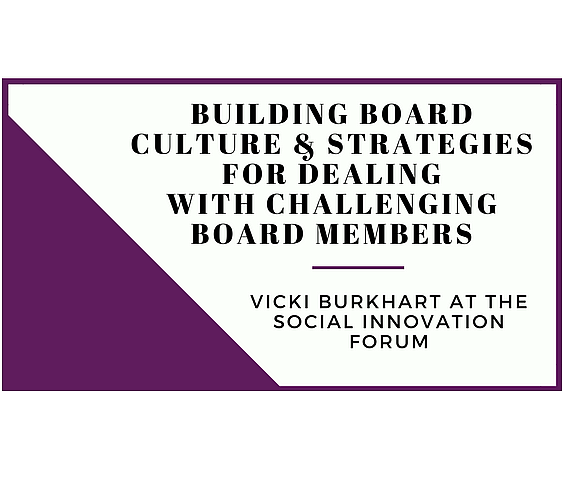
On April 24, the Social Innovation Forum hosted the second workshop in our board development series with Vicki Burkhart of the Burkhart Group. While session one focused on How to Build the Right Board for Organizational Growth, the second session gave tools for Building Board Culture & Strategies for Dealing with Challenging Board Members. The workshop included nonprofit leaders and board members from SIF's alumni portfolio, coworking members, and Social Innovator Accelerator Finalists. Here are some key takeaways.
Manage the Dynamics
Vicki shared some helpful some ground rules to manage the dynamics of your boardroom to produce efficient and productive meetings. A few of these simple, but powerful rules, included:
- Raising your hand and being called on - an elementary, yet effective, way to ensure only one person speaks at a time and a single person does not dominate the conversation.
- Implementing a “three response rule” limits discussion on a topic to three comments - productive, concise contributions should cover the bases and avoid repetition.
- Creating a “parking lot” – use a flip chart or white board to write down off-topic comments to return to later, rather than getting sidetracked in the middle of critical discussions.
Redirect Non-Productive Behavior
Every board experiences some difficult conversations. Though every board is different, there are often recurring personality types that can bring additional challenges to board management. Vicki discusses several “types” that she has seen on many boards throughout her career and brought suggestions for managing these board members. These included:
- “Bill the Bull Horn” dominates every conversation while raising the volume and discouraging others from sharing input. Meeting individually with “Bill” before board meetings and referencing his comments during the board meeting will make him feel “heard” without monopolizing the conversation. Establishing and enforcing clear ground rules for respectful participation can mediate overpowering voices so that all members feel encouraged to contribute.
- “Negative Nellie” brings recurring negativity and unproductive comments producing a dark cloud looming over discussions. Don’t allow this behavior to bring down the room. Choose to provide a positive for every negative comment and decide, as a group, to offer complaints and criticism only when alternative ideas and solutions are offered.
- “Failure to Launch Lois” constantly volunteers for tasks and joins committees, yet, when the time comes to deliver, she is unresponsive with little to no follow through. To prevent this cycle from continuing, avoid requests like “who would like to volunteer for this task?”. Instead, strategically align tasks with the expertise and interest of board members, and monitor progress. If the lack of task completion continues, meet with members individually to review their position description and candidly assess whether they truly have the time to commit to your board.
Consider the Effectiveness of Term Limits
Term limits written into a board position description gives potential and new board members a clear timeline for their engagement in your board. As Vicki highlighted, top-notch, committed board members will want to know exactly what is expected of them. Activating term limits requires an organization to have a pipeline of strong board candidates to fill future roles, as Vicki taught us in her first workshop. Transitioning new members onto the board keeps the organization fresh and motivated. Vicki suggests three-year board terms, with an opportunity to serve for a second term.
Establishing an Effective “Off-Boarding” Process
As the end of a valued board member’s term approaches, it behooves the organization to establish a clear off-boarding process, including avenues through which past board members can continue to provide their skill, expertise, and institutional knowledge. Consider establishing honorary or emeritus board positions or create an advisory board where past board members can remain engaged without the time demands and responsibilities of full board membership. A president’s council may organize annual lunch events with the board president where he/she can seek counsel, ideas, and feedback from valued members.
Utilize Retreats to Build Synergy Among Board Members
Board retreats are an excellent way to create a strong and connected board. An overnight retreat allows board members to disconnect from their other responsibilities and fully focus on the topics of discussion. To make those two days most effective, Vicki suggests making the retreat mandatory and scheduling far in advance to ensure the participation of all members. Establish clear objectives and plan enough time to address those goals. Leave plenty of room for discussion - retreats provide an ideal opportunity for your board to confront difficult conversations and brainstorm creative solutions.
To learn more about board development or set up a training at your organization, contact Vicki Burkhart of the Burkhart Group at vsb@burkhartgroup.com.
 Social Innovation Forum
Social Innovation Forum